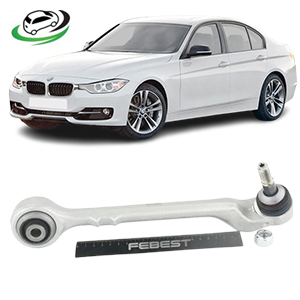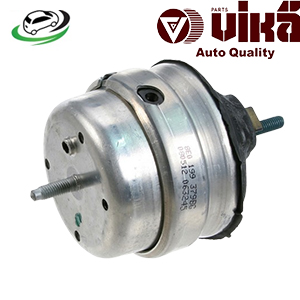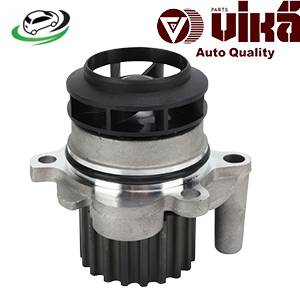-5%
In the realm of automotive systems, the water pump is an essential component of the engine’s cooling system. Its primary function is to regulate engine temperature by circulating coolant from the radiator to the engine block and back again. Without this circulation, the engine would quickly overheat, leading to catastrophic failure.
Water pumps have been integral to vehicles for over a century, continuously evolving in design to suit modern engines. They are typically located near the front of the engine and driven by the engine’s accessory belt or timing belt/chain, depending on the vehicle’s configuration. Understanding how this part functions, its importance, and how to maintain or replace it when necessary is key for any vehicle owner or mechanic.
2. How a Water Pump Works
The water pump works as the heart of the engine’s cooling system. When the engine is running, the water pump impeller—usually a small rotating disk with blades—spins, pushing coolant through the engine block, cylinder head, and radiator. Here’s a step-by-step breakdown of its operation:
- Coolant Circulation: The pump draws coolant from the radiator and pushes it into channels (called water jackets) within the engine block and cylinder head.
- Heat Transfer: As the coolant moves through the engine, it absorbs the heat generated by combustion and friction. This heat transfer is essential in preventing engine components from reaching critical temperatures that could result in warping or failure.
- Return to Radiator: Once the coolant has absorbed enough heat, it is routed back to the radiator, where air passing through the radiator fins cools the liquid. This cooled fluid is then recirculated back into the engine.
- Thermostat Regulation: The flow of coolant is often regulated by a thermostat, which opens or closes based on the engine’s temperature. If the engine is too cold, the thermostat stays closed, preventing coolant from circulating and allowing the engine to reach optimal operating temperature.
The entire process is continuous as long as the engine is running, ensuring that the engine operates within a safe temperature range.
3. Types of Water Pumps
Though most water pumps operate on the same basic principle, they can differ in design depending on the vehicle’s requirements:
- Mechanical Water Pump: This is the most common type and is typically driven by the engine’s timing belt, serpentine belt, or accessory belt. It relies on engine power to function, meaning it operates in direct correlation with the engine’s speed—higher engine speed results in faster coolant flow.
- Electric Water Pump: In modern vehicles, particularly hybrids and electric cars, electric water pumps are becoming more popular. These pumps are powered by electricity rather than engine belts, allowing them to operate independently of the engine’s speed. This makes them more efficient and enables better control of coolant flow, even when the engine is off.
- Auxiliary Water Pump: Some vehicles, especially high-performance or turbocharged cars, may have additional auxiliary water pumps to help manage extra heat generated by the engine or turbocharger. These pumps can work alongside the primary pump to enhance cooling efficiency.
4. Key Benefits of a Properly Functioning Water Pump
A well-maintained water pump provides several critical benefits to the engine and overall vehicle performance:
- Prevents Overheating: The most important role of the water pump is to keep the engine from overheating. By constantly circulating coolant, the water pump ensures that excess heat is dissipated.
- Promotes Engine Longevity: An engine running at optimal temperature experiences less wear and tear. Excessive heat can cause metal components to warp, head gaskets to fail, and seals to break. The water pump helps prevent such damage, contributing to engine longevity.
- Improves Efficiency: A water pump ensures that the engine operates at the correct temperature for fuel combustion. Engines that overheat or run too cold are less efficient, leading to increased fuel consumption and emissions.
- Smooth Operation of Other Components: Many water pumps in modern vehicles are integrated with the engine’s timing or accessory belts. A failing water pump can impact the operation of other vital components, including the alternator, power steering pump, and air conditioning system.
5. Common Signs of Water Pump Failure
Like any mechanical part, the water pump is subject to wear and tear. Identifying potential issues early can help prevent major engine damage. Here are some common symptoms of a failing water pump:
- Coolant Leaks: If you notice coolant pooling under the car, the water pump’s seal or gasket may be compromised. Coolant leaks are one of the earliest signs of pump failure.
- Overheating Engine: An obvious sign of a water pump malfunction is engine overheating. If the coolant isn’t circulating properly, the engine’s temperature will spike.
- Whining or Grinding Noises: A failing water pump often produces unusual sounds, typically due to a worn-out bearing. A high-pitched whining noise that varies with engine speed may indicate a loose or damaged water pump pulley.
- Steam from the Radiator: If you see steam coming from under the hood, the coolant is not cooling the engine properly, which could be a direct result of water pump failure.
- Coolant Temperature Warning Light: Many modern cars are equipped with dashboard warning lights that alert the driver when the engine’s temperature is too high. If this light comes on, the water pump may be to blame.
6. Water Pump Maintenance and Replacement
Water pumps generally last between 60,000 to 100,000 miles, depending on the vehicle and maintenance. Here are some best practices for maintaining your water pump:
- Regular Coolant Flushes: Over time, coolant can break down and become contaminated. Regularly flushing the coolant system helps remove debris and prevent corrosion that can damage the water pump.
- Check the Drive Belt: In vehicles where the water pump is belt-driven, inspect the belt for signs of wear or looseness. A frayed or loose belt can cause the pump to operate inefficiently or fail altogether.
- Inspect for Leaks: Periodically inspect the area under your vehicle and around the water pump housing for signs of coolant leaks. Catching leaks early can prevent complete water pump failure.
- Follow Manufacturer’s Recommendations: Always adhere to your vehicle manufacturer’s recommended service intervals for coolant system maintenance and water pump inspection.
When it’s time for a replacement, water pumps are often replaced alongside other components such as the timing belt, serpentine belt, or thermostat to save on labor costs. Replacement costs can vary depending on the vehicle and whether other parts are serviced at the same time, but it’s usually a worthwhile investment to prevent engine damage.
7. Conclusion
The water pump is a vital component in keeping an engine running smoothly by managing the flow of coolant and preventing overheating. Regular maintenance of the cooling system, including the water pump, is key to extending the life of your engine and maintaining vehicle performance. By being aware of common signs of failure and addressing issues promptly, you can ensure your vehicle stays on the road, running efficiently and safely.



